
Baeckea brevifolia is a species of flowering plant in the family Myrtaceae and is endemic to south-eastern New South Wales. It is a shrub with narrow egg-shaped to oblong leaves and white to pink flowers with nine to fifteen stamens.
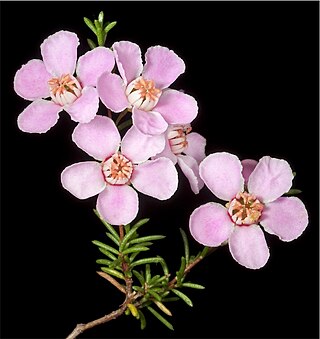
Babingtonia is a genus of 11 species of flowering plants in the myrtle fmily, Myrtaceae and is endemic to the south-west of Western Australia. Plants in the genus Babingtonia are glabrous shrubs with simple linear, lance-shaped or elliptic leaves with white flowers arranged singly or in groups of three to seven, in leaf axils.
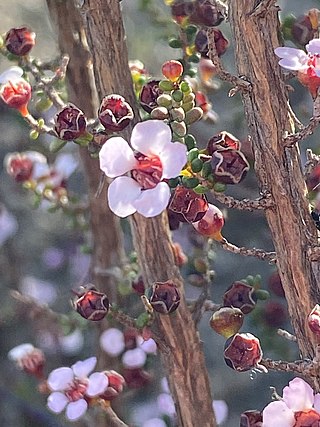
Rinzia orientalis, commonly known as desert heath-myrtle, is a species of flowering plant in the family Myrtaceae and is endemic to south-eastern Australia. It is a shrub with elliptic to narrowly oblong leaves and white or pale pink flowers usually with ten stamens.
Micromyrtus acuta is a species of flowering plant in the myrtle family, Myrtaceae and is endemic to the southwest of Western Australia. It is an erect shrub with small, oblong leaves and small white flowers in the upper leaf axils.
Micromyrtus chrysodema is a species of flowering plant in the myrtle family, Myrtaceae and is endemic to a small area of inland Western Australia. It is a densely branched shrub with small, narrowly oblong leaves and small white flowers.
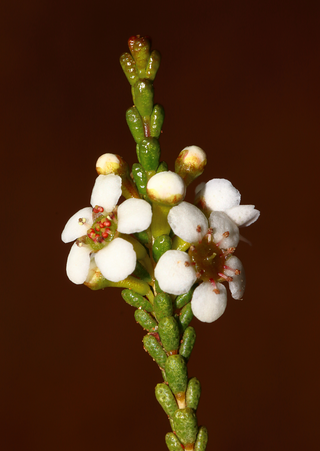
Micromyrtus clavata is a species of flowering plant in the family Myrtaceae and is endemic to inland Western Australia. It is an erect, compact or sprawling shrub with erect, egg-shaped leaves with the narrower end towards the base and small white flowers arranged singly in upper leaf axils.
Thryptomene johnsonii is a species of flowering plant in the family Myrtaceae and is endemic to a restricted area of Western Australia. It is a bushy shrub with rigid branches, egg-shaped leaves with the narrower end towards the base and pink flowers with five petals and usually eight stamens.

Thryptomene mucronulata is a species of flowering plant in the family Myrtaceae and is endemic to Western Australia. It is an erect shrub with upward-pointing, overlapping, egg-shaped leaves with the narrower end towards the base and pink flowers with five petals and ten stamens.

Babingtonia camphorosmae, commonly known as camphor myrtle, is a species of flowering plant in the family Myrtaceae and is endemic to the southwest of Western Australia. It is a prostrate to low-growing shrub with linear to thread-like leaves and white or pink flowers in groups of up to five, each flower with ten to thirteen stamens.

Babingtonia cherticola is a species of flowering plant in the family Myrtaceae and is endemic to the southwest of Western Australia. It is an erect shrub with linear leaves and white or pale pink flowers in groups of up to three, each flower with 16 to 26 stamens.
Babingtonia delicata is a species of flowering plant in the family Myrtaceae and is endemic to a small area in the southwest of Western Australia. It is a slender shrub with erect stems, linear leaves and bright pink flowers in groups of up to three, each flower with 4 to 8 stamens.
Babingtonia erecta is a species of flowering plant in the family Myrtaceae and is endemic to the southwest of Western Australia. It is an erect shrub with densely clustered, linear leaves and white or pale pink flowers in groups two to seven in leaf axils, each flower with 8 to 14 stamens.
Babingtonia fascifolia is a species of flowering plant in the family Myrtaceae and is endemic to the southwest of Western Australia. It is a shrub with erect, slender stems, linear leaves and white or pale pink flowers in groups two to seven in leaf axils, each flower with 19 to 23 stamens.
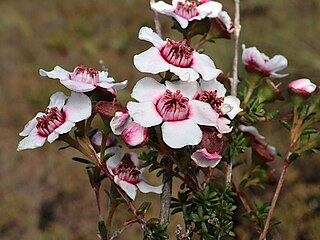
Babingtonia grandiflora, commonly known as the large flowered babingtonia, is a species of flowering plant in the family Myrtaceae and is endemic to the southwest of Western Australia. It is a shrub with erect or arching stems, linear leaves and white or pale pink flowers usually arranged singly in leaf axils, each flower with 11 to 25 stamens.
Babingtonia maleyae, commonly known as the Narrogin babingtonia, is a species of flowering plant in the family Myrtaceae and is endemic to the southwest of Western Australia. It is a compact shrub with narrowly egg-shaped to elliptic leaves and white flowers usually arranged singly in leaf axils, each flower with 17 to 20 stamens.
Babingtonia minutifolia is a species of flowering plant in the family Myrtaceae and is endemic to a small area in the southwest of Western Australia. It is an erect, widely spreading shrub with narrowly egg-shaped to elliptic leaves and pale pink flowers arranged singly in leaf axils, each flower with 16 to 19 stamens in a circle.
Babingtonia triandra, commonly known as triplet babingtonia, is a species of flowering plant in the family Myrtaceae and is endemic to a restricted area of the southwest of Western Australia. It is a low, spreading to almost prostrate shrub with linear leaves and white flowers usually arranged in groups of up to 16 in leaf axils, each flower with 3 widely spaced stamens.
Babingtonia urbana, commonly known as coastal plain babingtonia, is a species of flowering plant in the family Myrtaceae and is endemic to the southwest of Western Australia. It is a shrub with linear leaves and white or pale pink flowers usually arranged singly in leaf axils, each flower with 16 to 20 stamens in a circle.
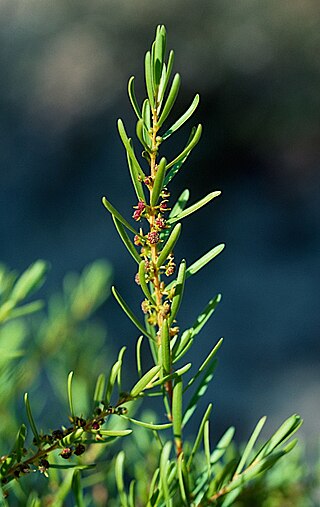
Stachystemon axillaris, commonly known as leafy stachystemon, is a species of flowering plant in the family Picrodendraceae and is endemic to the south-west of Western Australia. It is a monoecious shrub with simple, linear to narrowly elliptic or oblong leaves and small yellow flowers arranged singly in upper leaf axils.
Stachystemon mucronatus is a species of flowering plant in the family Picrodendraceae and is endemic to the south-west of Western Australia. It is a compact, monoecious shrub with narrowly oblong or narrowly elliptic leaves and small, greenish yellow flowers arranged singly in upper leaf axils.









